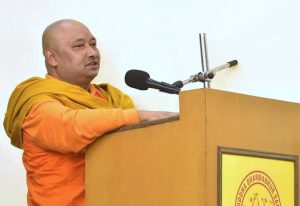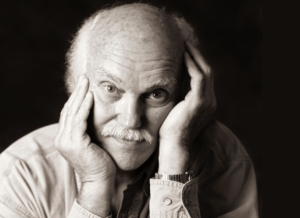
Buddha Pūrṇimā, or Vesak, commemorates the Buddha’s birth, enlightenment, and passing away (mahāparinibbāṇa). It is also a day to remember the Buddha’s unique and profound, yet subtle teachings that lead to the cessation of suffering (dukkha). Bangladeshi Buddhists, like their counterparts in South and Southeast Asia, have for centuries observed this auspicious day with faith, devotion, and reverence for the Triple Gems. Buddha Pūrṇimā is a day of communal harmony in which spiritual seekers of all races, traditions, and beliefs gather under the peaceful umbrella of the Buddha’s holy teachings, just as Prince Siddhattha sat beneath a Bodhi tree seeking the bliss of enlightenment to liberate himself and all sentient beings.
According to the South and Southeast Asian Buddhist calendar, the Buddha was born sometime in 563 BCE, on the eve of the Visākā or Baisāk full moon; he attained enlightenment in 528 BCE and entered mahāparinibbāṇa in 483 BCE. The Bengalis celebrated the Visākā or Baisāk full moon day as an auspicious day of Buddha Pūrṇimā. For thousands of years, Buddhists have observed Buddha Pūrṇimā as perhaps the most important Buddhist festival. To recognize the faith of global Buddhists, the United Nations (UN) General Assembly, in its resolution 54/115 of 1999, designated the Visākā full moon as the day of Vesak to acknowledge the contribution of Buddha’s teachings to human flourishing.
According to Buddhist tradition, the historical Buddha’s name was Siddhattha, and he was born into a royal family of the ancient Sakya (Sanskrit: Śākya) princely republic. Prince Siddhattha’s mother was Queen Mahāmāyā, and his father was King Suddhōdana. Queen Mahāmāyā of the Sakya Republic, who was about to give birth, was traveling from Kapilavasthu to Devadaha when she stopped midway at Lumbinī Grove, which is in what is now Nepal. The queen sought refuge in a secluded garden while suffering from the agony of pregnancy. In 563 BCE, Queen Mahāmāya gave birth to a baby boy named Siddhattha (Sanskrit: Siddhartha), which means “wish fulfilled,” under the canopy of two magnificent sal trees.
The Sakya realm rejoiced at the birth of Prince Siddhattha. They mourned the queen’s death, which happened seven days later. King Suddhōdana would then marry Queen Mahāmāya’s younger sister, Mahāpajāpatī Gotamī (Sanskrit: Mahāprajāpatī Gautamī), who had been caring for Siddhattha Gotama since his birth. Afterward, a wise sage called Asita visited Prince Siddhattha. He recognized the marks of future greatness for the baby boy. The seer predicted that the prince would attain the ultimate self-awakening and set the Wheel of Dharma in motion, extending his compassion for the welfare of many (Nalaka Sutta, Sutta Nipāta, 3.1).
Prince Siddhattha grew into a quiet and calm boy. He preferred solitude and was an inquisitive thinker who had a deep curiosity about the workings of the world. Even at an early age, Siddhattha inherently understood the bliss of a deepened meditative state. This experience, alongside his reflective nature, foreshadowed Siddhattha’s destiny. Recalling the prophecy of the seer Asita, King Suddhōdana tried to isolate him from the experience of worldly suffering. King Suddhōdana sheltered him within the royal grounds. Three palaces were built to ensure the happiness and protection of his son: a winter palace, a summer palace, and a palace for the rainy season (Aṅguttara Nikāya, 3.38). Being shrouded from the outer world, King Suddhōdana believed, would prevent Siddhattha from seeing any reality of suffering, illness, aging, or death. At the age of sixteen, Prince Siddhattha married a Sakya princess, Yasodharā (Sanskrit: Yaśodharā). Later, the marriage was blessed with the birth of a baby son whom they named Rāhula.
Despite the abundance of sensual pleasure, privilege, and refinement characterized by a royal life, Prince Siddhattha was continually drawn to understanding the nature of suffering. It was during an excursion from the palace that Prince Siddhattha beheld four memorable sights: the old man, the sick man, a corpse, and an ascetic. The pull to understand the nature of suffering grew stronger in his heart. It led Siddhattha to make a fateful decision to begin the start of a transformative journey.
Siddhattha decided to renounce his palace with all its extravagance, status, and wealth. Guided by his loyal attendant, Channa (Sanskrit: Chandaka), he left the Sakyan capital of Kapilavatthu (Sanskrit: Kapilavastu in present-day Nepal), his family members, the comfort of a luxurious life, wealth, and the court in the quest for the truth behind the subject of birth, aging, sickness, and death (The Noble Quest, Majjhima Nikāya, 26). The Bodhisattva (seeker of enlightenment) Siddhattha headed to Magadha (present-day Bihar, North India) to accomplish his goal. He was joined by two eminent masters, Ālāra Kālāma (Sanskrit: Ārāḍa Kālāma) and Uddaka Rāmputta (Sanskrit: Urdaka Rāmaputra), who introduced him to esoteric yoga and systems of meditation. As part of his intensive practice, Siddhattha fasted for days while exposing his body as if a skeleton cloaked in the skin. He nearly brought himself to the door of death.

Having engaged in six years of ascetic discipline, Siddhattha realized that the extreme practices between sensual indulgence (kāmasukhallikānuyogo) and self-mortification (attakilamathānuyogo) would not accomplish his goal of liberation (Setting the Wheel of Dharma in Motion, Saṃyukta Nikāya, 56.11). Because of his realization, Siddhattha relinquished the austere rituals and began his practice of the Middle Way (majjhimā paṭipadā). Deep investigation and wise reflection led him to understand the balance between mind and body. On the eve of Vesak (Vesakhā), the full moon day, in the region of Uruvela (present-day Bodh Gaya), Siddhartha found a tranquil place to meditate. By the bank of the Nerañjara River, the Bodhisattva quietly turned inward as he sat beneath a banyan tree (later called the Bodhi tree or the tree of enlightenment). After attaining deepened stages of meditation, his mind became perfectly calm, perfectly at ease and perfectly tranquil.
During the first watch of the night, Siddhartha connected to his past life experiences. As he transitioned into the second watch, he developed his “divine eye” or the eye of wisdom. Through direct knowledge, he understood the passing away and rebirth in terms of karma and its resultants. He realized the nature of suffering. With a gradual transition into the third watch, Siddhartha recognized the deepest and highest truths of existence: the origin of suffering and cessation of suffering through the doctrine of dependent origination (Awakening, Udāna, 1.3). The full moon shone brightly when the Bodhisattva came to complete awakening and transcended into the Buddha, the Perfectly Enlightened One. He attained the state of Nibbāṇa by discovering the truths of the nature of suffering, the origin of suffering, the cessation of suffering, and the path that leads to the cessation of suffering.

After the Buddha’s full awakening, he remained at Uruvela for seven weeks. Ready to share his subtle yet insightful knowledge, the Buddha moved to the Deer Park (Sanskrit: Mṛgadāva), Isipatana, in the region of Varanasi (present-day Sāranāth). Here, he reunited with five former fellow ascetics: Kondañña, Assaji, Bhaddiya, Vappa, and Mahānāma. The five ascetics were to become the Buddha’s first disciples to whom he delivered the discourse on “Setting the Wheel in the Motion” (Pāli: Dharmacakkappavattana Sutta; Sanskrit: Dharmachakrapravartana Sūtra). Starting with these five ascetics, the Buddha subsequently established a noble community for the first time, the Saṅgha. Building fellowship through an understanding of the teachings, increasing awareness, extending compassion, and promoting harmony and lovingkindness were supportive elements that fostered community within the Saṅgha. For the advancement of his subtle, yet sublime teachings, the Buddha formed the four-fold assembly which consisted of monks (bhikkhu); nuns (bhikkhunī); laymen (upāsaka), and laywomen (upāsikā).
The Buddha continued his teachings for forty-five years, accompanied by his noble community, the Saṅgha, until his final breath. At the age of eighty, the Buddha passed away in Kusinārā and attained the bliss of Nibbāṇa (Last Days of the Buddha, Dīgha Nikāya, 16). It was a Vesakhā, a full moon day, when the Buddha demised, just like his birth and enlightenment days. While every sunrise must also have a sunset, the Buddha’s demise marked the beginning of a new era after the Buddha-era, with the transmission of the Dharma (the teachings) and Vinaya (the disciplines) to his disciples and successors.

Nearly 2600 years ago, in his compassion, the Buddha set in motion a new era for the release of suffering in all sentient beings. On the eve of Vesakhā, the full moon day of Buddha Pūrṇimā, the Buddhist community remembers the Buddha’s acts with reverence. Bangladeshi Buddhists, like the Buddha’s followers in Southeast and South Asia, observe Buddha Pūrṇimā with reverence for the Buddha, his teachings, and the noble community. On this auspicious day, devotees begin the day with Buddha pūjā (offerings to the Buddha), meditate, and visit local monasteries for Saṅgha Dāna (offerings to the monastic members). Bengali Buddhists traditionally observe Buddha pūjā by offering flowers, incense, foods, and fruits, as well as and lighting up candles at their home altars and local monasteries. When Buddhist devotees perform Saṅgha Dāna, they provide the monastic members with the necessary requisites. Devotees receive the transmission of the five precepts (pañca-sīla) and the eight precepts (aṣṭā-sīla) in exchange. Buddhists firmly believe that if someone sincerely observes precepts (sīla) in daily life, they will avoid impurity and an unwholesome state of mind, bringing enormous benefit to himself, household life, and society.

In Bangladesh, the remarkable Buddha Pūrṇimā is celebrated not only by Buddhists, but also by non-Buddhist communities such as Islam, Hinduism, Christianity, and others. Over four decades, the Bangladesh government has declared the day of Buddha Pūrnīmā an official holiday concerning the Buddhist community’s faith, belief, and tradition. Both Buddhists and non-Buddhists join in a peaceful procession to boost communal harmony. The Buddha’s message of peace, love, and compassion for all sentient beings, reminds people to extend loving-kindness to all, spread harmony, and help each other on the journey to overcoming suffering. The remarkable Buddha Pūrṇimā is not only a significant event commemorating the legacy of the historical Buddha, but it is also a time for people to seek refuge under a peaceful umbrella, just as the Buddha inspired them to extend compassion and loving-kindness to all living creatures.
Sabbe sattā sukhi hontu! May all living beings be happy!
References
Bodhi, Bhikkhu. 1995. The Great Discourse of Causation: The Mahānidāna Sutta and its Commentaries. Kandy: Buddhist Publications Society.
Bodhi, Bhikkhu. 2000. The Connected Discourses of the Buddha, 2. Boston: Wisdom Publications.
Chowdhury, Sanjoy Barua. 2022. “The Buddhist Concept of Paṭiccasamuppāda Based on Pāli Manuscripts: Genesis, Meanings, Annotated Translation, Interpretation, and Doctrinal Significance”. Poligrafi 27 (105/106):3-20. https://doi.org/10.35469/poligrafi.2022.336.
Horner, I. B. 1995. The Collection of the Middle Length Saying, Vol 1. Translated by Majjhima Nikāya. Oxford: Pali Text Society.
Harvey, Peter. An Introduction to Buddhism: Teachings, History, and Practices. New York: Cambridge University Press, 2012.
Ñāṇamoli, Bhikkhu, and Bhikkhu Bodhi. 1995. The Middle Length Discourses of the Buddha. Translated by Majjhima Nikāya. Kandy: Buddhist Publication Society.
Ñāṇapoṇika Thera, trans. Sutta Nipāta, Konstanz: Christiani, 1977.
Related features from BDG
Fire Imagery in the Pali Canon
Related news reports from BDG
White House Hosts Buddhist Representatives for Fourth Annual Vesak Observance











